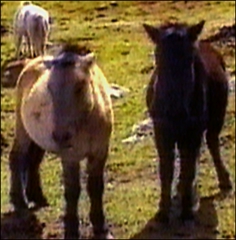|

Image Credits

Country of Origin: Tibet
The Riwoche horse is a very small horse, discovered in an isolated region of Tibet in 1995. Previously unknown to science, these small animals may be an evolutionary link between the prehistoric wild horse and the modern domestic horse, though it could also be a domesticated variety that reverted to a small size and primitive coloring. They are pony-sized and dun in color.
Discovery
The breed was discovered in 1995 in an isolated, 27 kilometres (17 mi) long valley reached only by crossing a 5,000 metres (16,000 ft) mountain pass. They were spotted by a team of explorers led by the French ethnologist Michel Peissel. While on an expedition to study another newly-discovered horse breed that Peissel had located in 1993, the Nangchen horse, he came upon a number of small horses in an isolated valley in the Riwoche region of Tibet. These animals were unknown to the rest of the world, but apparently used by the local Bon-po people, Peissel and his crew obtained blood samples from the herd for DNA testing.
It was speculated that the horse might be a relic population of wild horses. A British equine psychologist accompanying the expedition, Dr. Ignasi Casas, theorized that the Riwoche horse was a relic population due to living in near-complete isolation from other breeds for a very long time. Other hypotheses suggest it is possibly an evolutionary link between the prehistoric horse and the domesticated horse, but testing did not reveal genetic variance with other horses, which is in line with news reports indicating that they are used as pack and riding animals by the local villagers. Peissel noted the resemblance of the Riwoche horse to the Przewalski's horse, but also is certain the two are not related.
Characteristics
The Riwoche horse is actually pony sized, standing only 12 hands (48 inches, 122 cm) tall. They are said to resemble horses depicted in cave paintings. They are dun in color, with an angular body, upright mane and the primitive markings including a dorsal stripe and stripes on the back of the legs. These features are similar to those of other ancient horse breeds. They also have small ears, a rough coat. small jaw, straight, flat forehead, and unique, narrow "duck-bill" nostrils.
Their unusual appearance led Peissel to speculate that they could be a "living fossil." He noted that they strongly resembled a horse distinct from but often pictured with the Przewalski's horse in prehistoric cave art.
Subsequent Discoveries
On the same expedition, Peissel also discovered other isolated and unique species of megafauna, including a rare white-lipped deer, as well as what is believed to be the source of the Mekong river.
For More Information:
Tibetan discovery is
'horse of a different color'/CNN World News/From Correspondent Peter Humi
A Stone-Age Horse Still Roams a Tibetan Plateau/New York Times/By Marlise Simons/Published: November 12, 1995
|